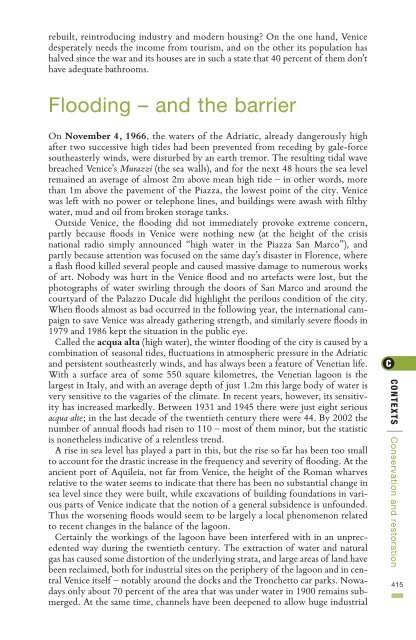You also want an ePaper? Increase the reach of your titles
YUMPU automatically turns print PDFs into web optimized ePapers that Google loves.
ebuilt, reintroducing industry <strong>and</strong> modern housing On <strong>the</strong> one h<strong>and</strong>, <strong>Venice</strong><br />
desperately needs <strong>the</strong> income from <strong>to</strong>urism, <strong>and</strong> on <strong>the</strong> o<strong>the</strong>r its population has<br />
halved since <strong>the</strong> war <strong>and</strong> its houses are in such a state that 40 percent of <strong>the</strong>m don’t<br />
have adequate bathrooms.<br />
Flooding – <strong>and</strong> <strong>the</strong> barrier<br />
On November 4, 1966, <strong>the</strong> waters of <strong>the</strong> Adriatic, already dangerously high<br />
after two successive high tides had been prevented from receding by gale-force<br />
sou<strong>the</strong>asterly winds, were disturbed by an earth tremor. <strong>The</strong> resulting tidal wave<br />
breached <strong>Venice</strong>’s Murazzi (<strong>the</strong> sea walls), <strong>and</strong> for <strong>the</strong> next 48 hours <strong>the</strong> sea level<br />
remained an average of almost 2m above mean high tide – in o<strong>the</strong>r words, more<br />
than 1m above <strong>the</strong> pavement of <strong>the</strong> Piazza, <strong>the</strong> lowest point of <strong>the</strong> city. <strong>Venice</strong><br />
was left with no power or telephone lines, <strong>and</strong> buildings were awash with filthy<br />
water, mud <strong>and</strong> oil from broken s<strong>to</strong>rage tanks.<br />
Outside <strong>Venice</strong>, <strong>the</strong> flooding did not immediately provoke extreme concern,<br />
partly because floods in <strong>Venice</strong> were nothing new (at <strong>the</strong> height of <strong>the</strong> crisis<br />
national radio simply announced “high water in <strong>the</strong> Piazza San Marco”), <strong>and</strong><br />
partly because attention was focused on <strong>the</strong> same day’s disaster in Florence, where<br />
a flash flood killed several people <strong>and</strong> caused massive damage <strong>to</strong> numerous works<br />
of art. Nobody was hurt in <strong>the</strong> <strong>Venice</strong> flood <strong>and</strong> no artefacts were lost, but <strong>the</strong><br />
pho<strong>to</strong>graphs of water swirling through <strong>the</strong> doors of San Marco <strong>and</strong> around <strong>the</strong><br />
courtyard of <strong>the</strong> Palazzo Ducale did highlight <strong>the</strong> perilous condition of <strong>the</strong> city.<br />
When floods almost as bad occurred in <strong>the</strong> following year, <strong>the</strong> international campaign<br />
<strong>to</strong> save <strong>Venice</strong> was already ga<strong>the</strong>ring strength, <strong>and</strong> similarly severe floods in<br />
1979 <strong>and</strong> 1986 kept <strong>the</strong> situation in <strong>the</strong> public eye.<br />
Called <strong>the</strong> acqua alta (high water), <strong>the</strong> winter flooding of <strong>the</strong> city is caused by a<br />
combination of seasonal tides, fluctuations in atmospheric pressure in <strong>the</strong> Adriatic<br />
<strong>and</strong> persistent sou<strong>the</strong>asterly winds, <strong>and</strong> has always been a feature of Venetian life.<br />
With a surface area of some 550 square kilometres, <strong>the</strong> Venetian lagoon is <strong>the</strong><br />
largest in Italy, <strong>and</strong> with an average depth of just 1.2m this large body of water is<br />
very sensitive <strong>to</strong> <strong>the</strong> vagaries of <strong>the</strong> climate. In recent years, however, its sensitivity<br />
has increased markedly. Between 1931 <strong>and</strong> 1945 <strong>the</strong>re were just eight serious<br />
acqua alte; in <strong>the</strong> last decade of <strong>the</strong> twentieth century <strong>the</strong>re were 44. By 2002 <strong>the</strong><br />
number of annual floods had risen <strong>to</strong> 110 – most of <strong>the</strong>m minor, but <strong>the</strong> statistic<br />
is none<strong>the</strong>less indicative of a relentless trend.<br />
A rise in sea level has played a part in this, but <strong>the</strong> rise so far has been <strong>to</strong>o small<br />
<strong>to</strong> account for <strong>the</strong> drastic increase in <strong>the</strong> frequency <strong>and</strong> severity of flooding. At <strong>the</strong><br />
ancient port of Aquileia, not far from <strong>Venice</strong>, <strong>the</strong> height of <strong>the</strong> Roman wharves<br />
relative <strong>to</strong> <strong>the</strong> water seems <strong>to</strong> indicate that <strong>the</strong>re has been no substantial change in<br />
sea level since <strong>the</strong>y were built, while excavations of building foundations in various<br />
parts of <strong>Venice</strong> indicate that <strong>the</strong> notion of a general subsidence is unfounded.<br />
Thus <strong>the</strong> worsening floods would seem <strong>to</strong> be largely a local phenomenon related<br />
<strong>to</strong> recent changes in <strong>the</strong> balance of <strong>the</strong> lagoon.<br />
Certainly <strong>the</strong> workings of <strong>the</strong> lagoon have been interfered with in an unprecedented<br />
way during <strong>the</strong> twentieth century. <strong>The</strong> extraction of water <strong>and</strong> natural<br />
gas has caused some dis<strong>to</strong>rtion of <strong>the</strong> underlying strata, <strong>and</strong> large areas of l<strong>and</strong> have<br />
been reclaimed, both for industrial sites on <strong>the</strong> periphery of <strong>the</strong> lagoon <strong>and</strong> in central<br />
<strong>Venice</strong> itself – notably around <strong>the</strong> docks <strong>and</strong> <strong>the</strong> Tronchet<strong>to</strong> car parks. Nowadays<br />
only about 70 percent of <strong>the</strong> area that was under water in 1900 remains submerged.<br />
At <strong>the</strong> same time, channels have been deepened <strong>to</strong> allow huge industrial<br />
CONTEXTS<br />
|<br />
Conservation <strong>and</strong> res<strong>to</strong>ration<br />
415







